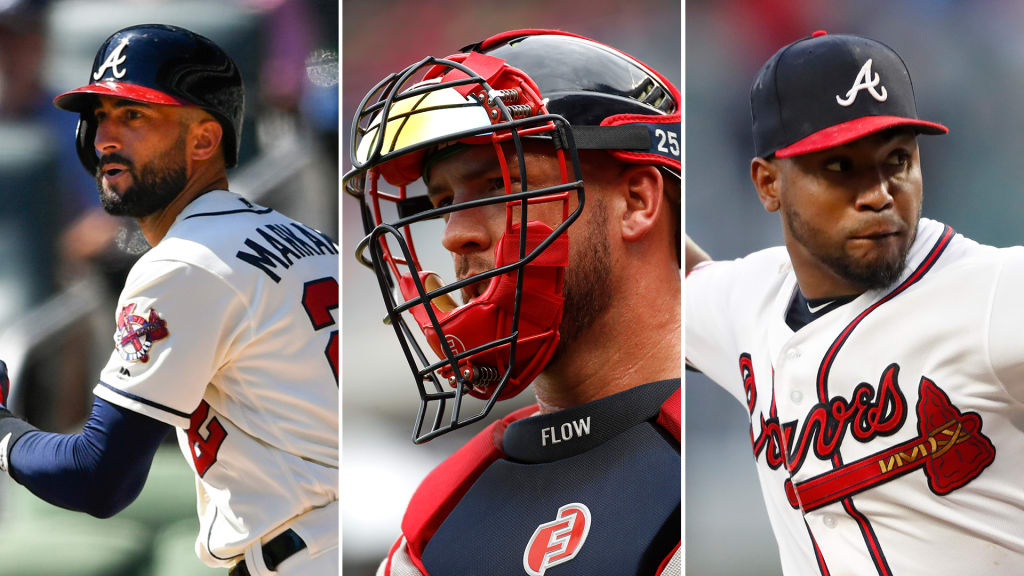
What percent chance would you put on the Tyler Flowers, Nick Markakis and Julio Teheran's options being picked up?
-- @scottcoleman55
As long as there is not unknown medical concern (and there has not be any indication of one), picking up Flowers’ $6 million option ($2 million buyout) is a slam dunk. You should never willfully enter an offseason looking for two catchers.
Given a decision will need to be made before teams have a good feel of how much certain free agents will cost and exactly which assets might be available via trade, I’m also expecting the Braves to pick up Markakis’ $6 million ($2M buyout) option. But you can make a strong argument that Matt Joyce could be retained for cheaper than that $4 million net and could better fill a platoon role until Cristian Pache or Drew Waters are deemed ready next year. For now, let’s put the odds on exercising the option at 65 percent.
Initially, I was thinking there was about a 35 percent chance the Braves would exercise Teheran’s $12 million option ($1M buyout). I’m now thinking 50 percent would be more accurate. The argument for exercising the option would center around the difficulty in replacing him with a proven innings eater. But along with recognizing he has completed at least 174 2/3 innings each of the past seven seasons, you also have to account for the possibility you may continue to see diminishing returns from this veteran (turns 29 in January) who just produced the National League’s worst Expected Fielding Independent Pitching mark and the third-highest walk percentage?
Will Sean Newcomb remain in the bullpen or is he a rotation candidate?
-- @martyjr0416
While evaluating what to do with Teheran, it should be known that the Braves will appease Newcomb by allowing him to compete for a rotation spot during Spring Training. This is essentially a no-risk plan. If Newcomb impresses by proving he can consistently throw strikes as a starter, the Braves could find themselves with a rekindled lottery ticket. If he struggles after having the benefit of logging double the amount of innings he’d get next spring as a reliever, he simply moves back to the bullpen.
So getting back to Teheran. As things currently stand, Mike Soroka, Max Fried and Mike Foltynewicz are the only projected members of the 2020 Atlanta rotation. Teheran and Newcomb are experienced internal options. Kyle Wright, Bryse Wilson, Ian Anderson or Tucker Davidson have the potential to become a rotation mainstay at any point next season.
Then, of course, there’s the possibility the Braves could acquire a potential top-flight starter via trade or free agency. To gain this additional starter via trade, the Braves would have to dip into this surplus of high-quality starting pitching prospects.
If the Braves are going to finally make noise in October, they will need to pair another top starter with Soroka. Committing $12 million to Teheran lessens the financial flexibility needed to satisfy this need. But this might be a necessary cost to pay to protect the depth, which would be diminished if this need is satisfied via trade.
Will the Braves ever win a postseason series?
-- @Coach_Griffin23
All kidding aside, this latest early postseason exit should hurt worse than any experienced over the past decade. Now that the Nationals are on the brink of going to the World Series, it’s even more evident what Atlanta squandered.
Freddie Freeman contends his right elbow didn’t bother him, but his play made this hard to believe. Unfortunately, the only way to eliminate this problem was via the surgical procedure he’s expected to undergo to remove the bone spur.
But beyond Freeman, what if Chris Martin had not pulled his oblique in Game 1 of the National League Division Series? Would there have even been a need for a Game 4, when multiple squandered scoring opportunities led to Teheran (Martin’s roster replacement) allowing a run in the 10th inning? Had the Braves preserved that two-run lead in Game 1, we might not be asking why Mike Soroka was limited to one start. But for now, we’re just reminded that maximizing opportunities with your best option should always trump something like home/road splits.
The Braves players understandably didn’t like being asked about the city or franchise’s postseason futility. But the only way to eliminate this narrative is to change it. This year’s decisive blow came courtesy of a 10-run first in Game 5. But the fatal bleeding began during the latter innings of Games 1 and 4.
Austin Riley seems like the wild card of the offseason. What are the Braves plans with him?
-- @VinceDacus
Riley might be in the wild card of the offseason in that he stands as one of the many attractive prospects the Braves could move this winter to fill an immediate need. But for now, he just projects to provide insurance in the event the Braves don’t re-sign Josh Donaldson.
If Donaldson doesn’t return, Riley or Johan Camargo might be the top third-base options. Riley or Adam Duvall could also platoon with Markakis at the start of next year. Regardless of the role, the young slugger still possesses tremendous potential value.
Through the first 43 games of his career, Riley hit 14 homers (11.8 AB/HR) with a .908 OPS and a 32.6 percent strikeout percentage. The swing-and-miss frequency and plate discipline was a concern during this successful stretch. But I don’t think anybody expected him to fall as hard as he did -- four homers, a .513 OPS and a 42 percent strikeout rate over the remainder of the season.
Per Baseball Reference’s Play Index, the only players younger than 23 years old to hit at least 15 homers and strike out once every 2.6 at-bats in a season are Riley and the Twins’ Miguel Sanó in 2015. Sanó has endured some frustrating stretches, lowlighted by being sent to the Minors in 2018. But as he belted 34 homers and produced a .923 OPS this year, he showed the value of remaining patient with power.



